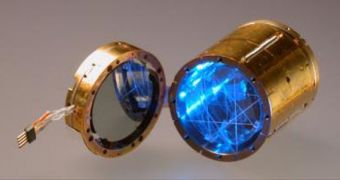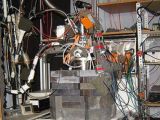Though no clear evidence documenting the existence of dark matter was ever produced, astronomers believe it exists because, if not, they simply cannot explain phenomena in the Universe. Since the type of matter was first proposed, a number of years ago, all sorts of instruments have been mounted on telescopes, in an attempt to discover traces of it. In spite of experts' best efforts, only moderate success was achieved, and the existence of dark matter was never proven. Now, a new device, of which a prototype is already finished, promises to finally shed some light on this mystery.
Developed by an international team of scientists, based at the University of Zaragoza (UNIZAR), in Spain, and the Institut d'Astrophysique Spatiale (IAS), in France, the new instrument is, its creators say, a “scintillating bolometer.” “One of the biggest challenges in physics today is to discover the true nature of dark matter, which cannot be directly observed – even though it seems to make up one-quarter of the matter of the Universe. So we have to attempt to detect it using prototypes such as the one we have developed,” Eduardo Garcia Abancens, who is a research scientist at the UNIZAR Laboratory of Nuclear Physics and Astroparticles, tells SINC.
The new prototype has already undergone preliminary testing at the Canfranc Underground Laboratory in Huesca, Spain, experts report. The international project is called ROSEBUD, which stands for Rare Objects SEarch with Bolometers UndergrounD. The team has been working on cryogenic detectors for the better part of the last decade, and they have created instruments that function extremely close to absolute zero, or -273.15 degrees Celsius. The newest device is the 46-gram scintillating bolometer, which features a crystal “scintillator,” made up of bismuth, germinate and oxygen (Bi4Ge3O12).
“This detection technique is based on the simultaneous measurement of the light and heat produced by the interaction between the detector and the hypothetical WIMPs (Weakly Interacting Massive Particles) which, according to various theoretical models, explain the existence of dark matter. The new scintillating bolometer has performed excellently, proving its viability as a detector in experiments to look for dark matter, and also as a gamma spectrometer (a device that measures this type of radiation) to monitor background radiation in these experiments,” Garcia Abancens adds.
The amazing research is part of the European EURECA project (European Underground Rare Event Calorimeter Array). The goal of this initiative is to eventually construct a one-tonne cryogenic detector, to be used for clearly confirming or infirming the existence of dark matter in the Universe. Details of the BGO crystals and the new bolometer are published in the latest issue of the respected scientific journal Optical Materials.

 14 DAY TRIAL //
14 DAY TRIAL // 
